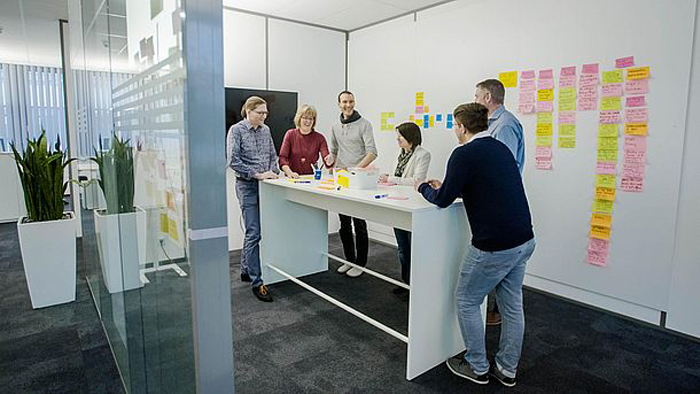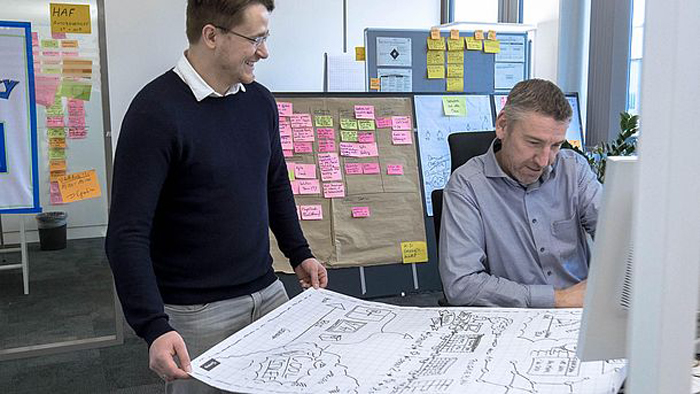A delicate job: what does a Scrum Master actually do?
Denis Gubin is a scrum master in the Agile Centre of Excellence at Volkswagen Group IT. Sounds complicated? The job has a lot more to do with people than it might seem at first glance.
Four weeks have gone by again. It’s time for scrum master Denis Gubin and his development teams to review their collaborative efforts over the past month. Gubin has made a sort of star with tape on the wall. Its five arms represent “positive”, “negative”, “do more”, “do less”, and “ideas/measures”. Denis Gubin states the subject: the focus today is on coding and software quality. The assembled colleagues write on post-it notes and begin sticking them to the wall.
Talking, sharing and interpreting
The objective of this meeting: the team wants to get better. Each team member presents their ideas in turn and distributes the colourful notes around the ever-larger star. For the scrum master, this is a moment for careful listening. Listening, for one, to what the colleagues have to say about the collaboration within the team. But what is almost more important is what they don’t say. Gubin has to pay close attention to the subtext: every meeting gives him the opportunity to probe whether everything in his teams is running smoothly. That’s why he generally moderates the proceedings. But the mood today is excellent. Denis Gubin clearly did his job well.
The scrum method

The scrum method is based on the fundamental assumption that teams achieve the best results when they are self-organized. The idea is to increase the motivation and fun within the team while boosting product quality and customer satisfaction. Some roles are fixed, and there is dynamic interaction consisting of continuous, rapid exchanges of information. The agile approach can be applied not only to software development; the design of a car can also be devised as a scrum project. But even such an agile process needs someone to establish rules and monitor the project, and make corrections to it. That is the job of the Scrum Master.
Simple principle, big transition

Gubin’s teams continuously develop software for Group logistics and production and handle projects for all brands within the Group. For each project, the so-called product owner manages the list of requirements for the respective project. These requirements are worked through in recurring four-week cycles called sprints. The team members themselves decide who will assume which task within the next sprint. After this, at the end of the sprint, team members then discuss whether these decisions were effective or not.
Innovation is getting faster
“Swarm intelligence” is a highly regarded concept in agile software development. “In this fast-paced age, no single person can assume the role of thought leadership for a group,” says Gubin. Innovations, particularly in the field of technology, are simply moving too fast for that. Gubin’s job is to successfully unleash the know-how and capabilities of the groups. To do so, he makes sure that the developers don’t fall back into old ways of thinking. For instance, they are encouraged not to give similar tasks to the same colleagues over and over, as this leads to the formation of knowledge silos. “Changing these types of behaviour is a marathon,” says Gubin.
Scrum Master as coach
Self-organisation also means responsibility. So, one key aspect of the scrum process is courage. Gubin regularly encourages his team members to make bold decisions. At the same time, he sees to it that they are accepted on the outside. “I’m happy when the teams try things that they would have been hesitant to try previously”. In the process, he never specifies the solution but instead recommends approaches. He’s a coach, not a supervisor.
Day-to-day effort
This re-thinking and implementation in daily practice requires a lot of effort. Is it worth it? Gubin is convinced: yes! Because his scrum teams determine the course that their projects take, they identify more strongly with the results. Their motivation increases and with it the fun factor. The quality of the developed software benefits from this. The method also holds benefits for the teams’ internal customers within the Group. They can transparently follow what is currently being worked on. And they are more closely tied into the planning of the processes.
You can’t be afraid of problems
Problems emerge quickly with the tight pacing of scrum and the recurring rituals of the process – which means that they can be addressed more quickly. Gubin sees this as one of the great advantages of the agile method. Of course, a scrum master can’t be put off by conflicts that arise. If the team had idle time in the last sprint, for example, then the sprint goals weren’t properly set, explains Gubin. Working together with colleagues to determine how agile requirements management can look in their context is his job as an agile coach.
Visualisation is important
Gubin’s approach consists of viewing the tasks assigned for each project through a drawing of a small factory: this allows team members to understand what contribution they have to make and understand clearly that a good product has to roll off the line. Gubin enjoys drawing comics in his free time as well. And the multifaceted process is made much more tangible with his sketched factory. “If you can’t get people excited about doing things in a new way, then this is the wrong job”, says Gubin in sum.
Source: TOGETHER.net – Volkswagen AG
